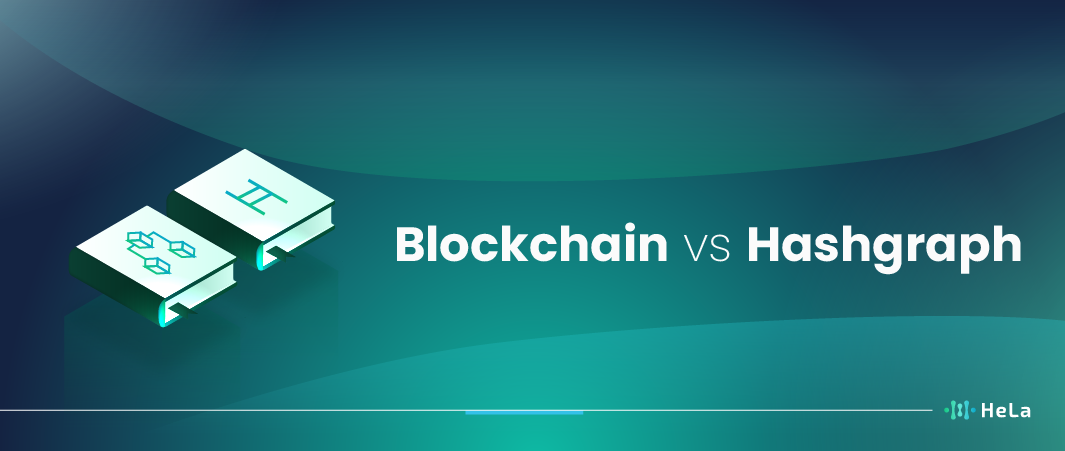In the fast-paced realm of technology, two emerging players, blockchain and Hashgraph, are causing quite a stir. They both hold the promise of revolutionizing various industries, but they take different paths to get there. Let’s explore the basics of blockchain vs Hashgraph and weigh their pros and cons. By the end of this discussion, you’ll have a better grasp of which technology might be the right fit for your specific needs.
Blockchain, which gained fame through cryptocurrencies like Bitcoin, is essentially a decentralized ledger that records transactions in blocks, creating a chain. Its transparency and security features have made it appealing for applications beyond finance, such as supply chain management and voting systems. However, it’s worth noting that its scalability and energy consumption have posed challenges.
Hashgraph, on the other hand, uses a different approach called gossip about gossip, offering faster consensus and potentially lower energy consumption. It shows promise for applications where real-time performance and scalability are crucial. However, it’s a relatively newer technology compared to blockchain, and its adoption is still evolving. In the end, the choice between blockchain vs Hashgraph depends on your specific use case and the trade-offs you are willing to make.
Understanding Blockchain

The concept of blockchain technology can be visualized as a series of interconnected digital blocks. Each block in the chain represents a set of transactions or data. These blocks are linked together in a chronological order, forming a chain. The connections between blocks are secured using cryptographic principles, ensuring that once data is recorded, it cannot be altered without altering all subsequent blocks. This makes the blockchain highly secure and tamper-resistant.
Also Read: What is a Blockchain Oracle? Basic Principles to Advanced Applications
The blockchain is decentralized, meaning that it is not stored on a single server or managed by a single entity. Instead, it is distributed across a network of computers, each of which holds a copy of the entire chain. This decentralization enhances the security and integrity of the data.
Key features of blockchain include:
- Transparency: Transactions are visible to everyone on the network, fostering a high level of transparency.
- Immutability: Once recorded, the data in any given block cannot be altered without the alteration of all subsequent blocks, which requires consensus of the network majority.
- Decentralization: No single entity controls the blockchain, making it a democratically managed system.
- Security: The use of cryptographic techniques makes the blockchain highly secure against fraud and hacking.
- Consensus Mechanisms: Methods like Proof of Work (PoW) or Proof of Stake (PoS) are used to validate transactions and add new blocks to the chain.
Blockchain technology has found applications beyond cryptocurrencies, including in areas like supply chain management, voting systems, identity verification, and more, due to these inherent features.
The Pros of Blockchain

The benefits of blockchain technology are significant and diverse, offering transformative possibilities in various sectors. Here are some of the key advantages:
Decentralization
A primary benefit of blockchain is its decentralized structure. Unlike traditional systems, blockchain operates without a central authority, reducing dependency on intermediaries. This decentralization can democratize processes, making them more transparent and accessible to all network participants. It eliminates the need for intermediaries, often resulting in cost reductions and increased efficiency.
Enhanced Security
Blockchain technology employs advanced cryptographic techniques to secure data transactions. Each transaction is encrypted and linked to the previous one, creating an unbreakable chain. This structure makes it highly resistant to hacking and fraud. The immutable nature of blockchain ensures that once data is recorded, it cannot be altered without the consensus of the network, thus preserving data integrity and trust.
Transparency
In a blockchain, all transactions are recorded on a distributed ledger, which is accessible to every participant in the network. This transparency ensures that all activities are visible, making it nearly impossible to engage in fraudulent activities without detection. This level of openness fosters a high degree of trust among users and can be particularly beneficial in sectors like finance, supply chain management, and public services.
Efficiency and Speed
Traditional banking and transaction systems can be time-consuming, often involving multiple intermediaries and a lot of paperwork. Blockchain streamlines these processes, enabling faster transactions that can occur 24/7. This efficiency is particularly beneficial in cross-border transactions, where blockchain can significantly reduce transfer times and costs.
Traceability and Accountability
In supply chain management, blockchain can be used to create a transparent and unalterable record of the entire journey of a product – from production to delivery. This traceability can help in verifying the authenticity of products and preventing fraud. It also allows for greater accountability as every step of the supply chain is recorded and verifiable.
Smart Contracts
Blockchain enables the use of smart contracts – self-executing contracts with the terms of the agreement directly written into lines of code. These contracts automatically enforce and execute the terms of an agreement based on predefined rules, reducing the need for intermediaries and lowering the chances of disputes.
Access to New Markets
Blockchain can open up new markets, particularly in areas where access to traditional banking systems is limited. By using blockchain and cryptocurrencies, businesses and individuals can engage in global trade more easily, without the constraints of conventional banking systems.
Innovation and New Business Models
Blockchain technology fosters innovation by enabling new business models. The decentralized nature of blockchain provides opportunities for creating decentralized applications (dApps) that can operate autonomously, opening up possibilities in areas like finance (DeFi), gaming, and online marketplaces.
Overall, blockchain’s potential extends far beyond its initial application in cryptocurrencies. Its ability to provide secure, transparent, and efficient transactions can revolutionize various industries, making processes more democratic, reliable, and accessible.
The Cons of Blockchain

The development and adoption of blockchain technology have brought about significant innovations, particularly in the areas of digital currencies, smart contracts, and decentralized applications. However, it is essential to recognize that blockchain, like any technology, comes with its own set of challenges and limitations. Here are some of the key cons associated with blockchain technology:
Scalability Issues
One of the most prominent challenges faced by blockchain technology, especially in public networks like Bitcoin and Ethereum, is scalability. As the number of transactions on these networks increases, they can become slower and more expensive to use. This is because each transaction needs to be verified and recorded across multiple nodes, which can be time-consuming and resource-intensive. The issue of scalability has led to the development of various solutions, such as layer-2 scaling solutions and alternative consensus mechanisms, but it remains a significant hurdle for widespread blockchain adoption.
High Energy Consumption
Certain blockchain networks, especially those that use a proof-of-work (PoW) consensus mechanism like Bitcoin, require substantial computational power. The process of mining in these networks involves solving complex mathematical problems, which necessitates the use of powerful and energy-intensive computer systems. This has led to concerns over the environmental impact of these networks, with the high energy consumption contributing to larger carbon footprints. In response, there’s a growing interest in more energy-efficient consensus mechanisms like proof-of-stake (PoS).
Complexity and High Costs of Implementation
Implementing blockchain technology can be complex and costly. It often requires significant technical expertise and infrastructure, which can be a barrier for smaller businesses or organizations with limited resources. The development of blockchain applications can also be time-consuming and requires a thorough understanding of the underlying technology. This complexity can hinder the adoption and integration of blockchain solutions in various industries.
Regulatory and Legal Uncertainty
Blockchain technology exists in a relatively new and rapidly evolving legal and regulatory landscape. Many countries and jurisdictions are still in the process of developing regulations that adequately address the unique aspects of blockchain and cryptocurrencies. This uncertainty can create challenges for businesses and individuals looking to adopt blockchain technology, as they may face unforeseen legal and regulatory hurdles.
Security Concerns
While blockchain is often praised for its security features, it is not immune to security risks. Issues such as the potential for 51% attacks (especially in smaller, less secure networks), smart contract vulnerabilities, and the irreversible nature of blockchain transactions can pose significant risks. Ensuring the security of blockchain networks and applications requires ongoing vigilance and the development of robust security protocols.
Interoperability Issues
The blockchain ecosystem comprises numerous distinct blockchains, each with its own protocols, consensus mechanisms, and features. This lack of interoperability can be a hurdle for the seamless exchange of information and value across different blockchain networks. Efforts are being made to develop interoperability solutions, but this remains an area that needs further development for blockchain technology to reach its full potential.
Understanding Hashgraph
Hashgraph is a distributed ledger technology that differs significantly from blockchain, the technology underlying cryptocurrencies like Bitcoin and Ethereum. Here’s a more detailed explanation:
Directed Acyclic Graph (DAG)
The key distinction between Hashgraph and traditional blockchain is its underlying structure. While blockchain is based on a linear sequence of blocks, Hashgraph uses a DAG. In this structure, each node directly connects to multiple other nodes, creating a web-like network. This design allows for more efficient handling of transactions and data.
Faster Consensus Mechanism
Hashgraph’s DAG structure enables a quicker consensus mechanism compared to blockchain’s Proof of Work (PoW) or Proof of Stake (PoS). The Hashgraph algorithm uses a process called “gossip about gossip,” where nodes rapidly share information about transactions and their knowledge of the network. This leads to faster agreement on transaction order and history without requiring the intense computational work seen in PoW.
Scalability
One of the significant advantages of Hashgraph is its scalability. Due to its efficient consensus mechanism and the DAG structure, it can handle a higher volume of transactions per second compared to traditional blockchains. This makes it more suitable for applications requiring high-throughput processing, like microtransactions or distributed applications with many users.
Fairness and Security
Hashgraph claims to offer fairer transaction ordering, as the time-stamping process is more resistant to manipulation. In terms of security, it uses asynchronous Byzantine Fault Tolerance (aBFT), which is considered one of the most robust security models, protecting against malicious actors even in cases where a portion of nodes are compromised.
Applications
Like blockchain, Hashgraph can be used for various applications, including cryptocurrencies, decentralized applications (dApps), and digital identity solutions. However, its unique characteristics make it potentially more suitable for specific use cases that demand high transaction speed and scalability.
Patented Technology
Unlike most blockchain technologies, which are open-source, Hashgraph is patented. This means that its development and use are controlled by Swirlds, the company that created Hashgraph. This has implications for its adoption and development in the wider distributed ledger technology community.
Hashgraph presents a novel approach to distributed ledger technology, offering advantages in speed, scalability, and fairness. However, its adoption and development are influenced by its patented status, setting it apart from the open-source ethos prevalent in the blockchain community.
The Pros and Cons of Hashgraph
Hashgraph, a relatively newer form of distributed ledger technology, presents a unique set of advantages and disadvantages when compared to traditional blockchain technologies. It’s essential to understand these in detail to evaluate Hashgraph’s potential impact and suitability for various applications in the evolving digital landscape. Here’s an extended analysis:
Advantages of Hashgraph
- Rapid Transaction Processing: One of the standout features of Hashgraph is its ability to handle thousands of transactions per second (TPS). This is a significant improvement over many traditional blockchain systems, which are often limited in transaction speed.
- Enhanced Scalability: Thanks to its innovative approach to consensus and transaction recording, Hashgraph can scale up efficiently, making it an attractive option for large-scale applications that demand high throughput.
- Innovative Consensus Mechanism: The platform utilizes a unique approach to reaching consensus, which ensures that the transaction order is fair and not easily manipulated. This aspect is particularly important in applications where the sequence of transactions is critical.
- High-Security Standards: Hashgraph is designed to be resilient against various types of cyber threats, including DDoS attacks, Sybil attacks, and more. This level of security is paramount in an era where digital assets and transactions are increasingly targeted by malicious actors.
- Lower Energy Consumption: Unlike some blockchain technologies, particularly those using Proof of Work (PoW) consensus mechanisms, Hashgraph is more energy-efficient. This makes it a more environmentally friendly option in the long term.
- Reduced Resource Requirement: The efficiency of Hashgraph also translates to lower computational and resource requirements, potentially lowering costs and making it accessible to a broader range of users and developers.
Also Read: Blockchain Vulnerability: Assessing and Mitigating Security Threats
Disadvantages of Hashgraph
- Governance Structure: The governance model of Hashgraph, centered around a council of selected members, contrasts with the fully decentralized model that many blockchain enthusiasts advocate. This centralized approach could lead to potential biases and uneven power dynamics.
- Centralized Control: The control exerted by a limited group might raise concerns about the long-term independence and neutrality of the platform, especially compared to more decentralized blockchain networks.
- Proprietary Nature: Hashgraph’s codebase is not entirely open-source, which can be a significant drawback for those who value the transparency and community-driven development characteristic of many blockchain projects.
- Adoption Challenges: As a relatively new technology, Hashgraph faces challenges in terms of user and developer adoption. The lack of a large, established community can slow down innovation and integration into mainstream applications.
- Interoperability with Existing Systems: Hashgraph might face challenges in integrating with existing blockchain and legacy systems, limiting its immediate applicability in certain sectors.
- Developer Familiarity and Tooling: Given its unique architecture, there might be a steeper learning curve for developers, and a lack of mature tooling compared to more established blockchain platforms.
While Hashgraph presents promising features in terms of speed, scalability, and security, it also faces significant challenges related to centralization, transparency, and widespread adoption. Its long-term success will likely depend on how these issues are addressed and how effectively it can integrate into the broader ecosystem of distributed ledger technologies.
Conclusion
In the ongoing debate of blockchain vs Hashgraph, each technology has its own set of advantages and disadvantages. Blockchain, with its transparency and decentralization, is a trusted choice for applications that prioritize security and trust. On the other hand, Hashgraph’s speed and scalability make it a strong contender for applications requiring high-performance transactions.
Ultimately, the choice between blockchain and Hashgraph depends on the specific needs and goals of your project. It’s essential to carefully consider the pros and cons of each technology and weigh them against your project’s requirements. As both technologies continue to evolve, they are likely to find their unique niches in various industries, driving innovation and transformation in the digital landscape.
Disclaimer: The information provided by HeLa Labs in this article is intended for general informational purposes and does not reflect the company’s opinion. It is not intended as investment advice or recommendations. Readers are strongly advised to conduct their own thorough research and consult with a qualified financial advisor before making any financial decisions.

Joshua Soriano
I am a writer specializing in decentralized systems, digital assets, and Web3 innovation. I develop research-driven explainers, case studies, and thought leadership that connect blockchain infrastructure, smart contract design, and tokenization models to real-world outcomes.
My work focuses on translating complex technical concepts into clear, actionable narratives for builders, businesses, and investors, highlighting transparency, security, and operational efficiency. Each piece blends primary-source research, protocol documentation, and practitioner insights to surface what matters for adoption and risk reduction, helping teams make informed decisions with precise, accessible content.
- Joshua Soriano#molongui-disabled-link
- Joshua Soriano#molongui-disabled-link
- Joshua Soriano#molongui-disabled-link
- Joshua Soriano#molongui-disabled-link

